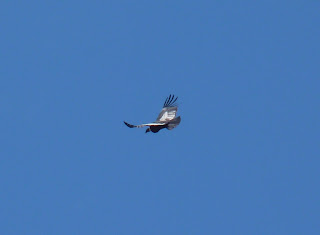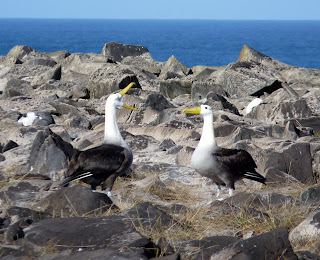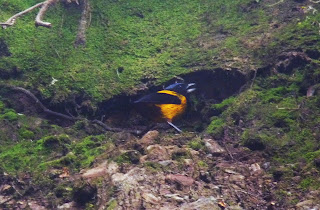The new year has scarcely begun and I have already seen what will almost certainly be in my top ten birds of 2011. Like a feathered mouse, the Yellow Rail is widely regarded as being one of the hardest to see breeding birds in the United States.
A few people have emailed me asking for details/advice on seeing this elusive bird. For their sake, I've written a quick narrative about our find:
Expectations were low (and that always helps). After spending a couple hours sorting through Chipping Sparrows looking for an "easy" Lark Sparrow at the nearby North River Golf Course, Jacob Socolar, Robert and James Meehan and I were struggling to stay dry while fording a small tidal creek at North River Marsh.
Wet and mud-splattered, we proceeded to tie ropes anchored with water-filled juice bottles around our ankles. Thus manacled like convicts we combed through a vast Spartina prairie which Jacob assured us was John Fussell's most reliable spot for Yellow Rails.
After about two hours puzzling over fleeting glances of ammodramus sparrows and marsh wrens and the occasional misstep into a deep hollow hidden by Needle Rush or a patch of quick mud we were cold and filthy and nearly ready to admit defeat. Suddenly a small yellow-and-brown streaked bird popped up from near our rope. It fluttered away from us for about three seconds showing obvious white patches in its wings before settling back down and vanishing some 60 feet ahead.
I recorded our unsuccessful attempt to flush it again.
No, you won't see the bird in this clip, but it does show our setup and the sort of habitat in which we found it.
The sighting left us ecstatic and we were hardly bothered when we again were unable to find the Lark Sparrow. We finished our day at Fort Macon State Park where we found a few Common Eiders near the rock jetty.
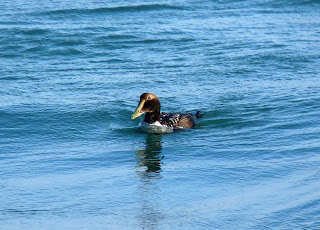
Jacob, Robert and Jimmy had to drive back to Durham that night, but I stuck around Emerald Isle for the weekend. It would be a longer and birdier stay than I had planned!
The next day I went back to the golf course and found the Lark Sparrow almost immediately in the exact location we had spent hours searching the previous day.

That's birding for you I guess.

I spent the afternoon birding Harker's Island where the best bird was probably a wooden decoy of a Long-tailed Duck I found inside the museum.
On Sunday I braved the frigid temperature and kayaked out to the Rachel Carson Estuarine Reserve, a shorebird paradise across a channel from Beaufort.
It was swarmed with Dunlin, Oystercatchers, Willets, Marbled Godwits and Short-billed Dowitchers.
Here's a dowitcher foraging in the classic "sewing-machine" style.
Bird highlights of the trip were Red Knot

and Piping Plover.

The next morning I woke up to blizzard conditions. I had never even seen snow at the beach before and I was staring out into a white-out at Emerald Isle!
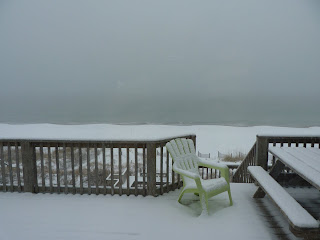
The icy roads made my long weekend even longer. Madness!
The weather did turn the ocean into a lake, which made for excellent sea-watching conditions when visibility wasn't diminished by precipitation.
------
I received a lot of responses to my last post about my top ten birds of 2010. I'll go over those next post.
------
So far I have come up with 5 target birds for 2011:
1. Golden Eagle (if I were going to the neotropics this year I would replace "Golden" with "Harpy")
2. Black Rail (the Yellow Rail has me foolishly optimistic)
3. Gryphon Vulture (I missed this 4 years ago in Crete, hoping to see one in Croatia)
4. Roller
5. Eurasian Bee-eater
Help me add more!
------
Ali inspired me to try this bird-a-day silliness. It will be fun while it lasts, but I see no chance of making it past February.
Birds so far:
A few people have emailed me asking for details/advice on seeing this elusive bird. For their sake, I've written a quick narrative about our find:
Expectations were low (and that always helps). After spending a couple hours sorting through Chipping Sparrows looking for an "easy" Lark Sparrow at the nearby North River Golf Course, Jacob Socolar, Robert and James Meehan and I were struggling to stay dry while fording a small tidal creek at North River Marsh.
Wet and mud-splattered, we proceeded to tie ropes anchored with water-filled juice bottles around our ankles. Thus manacled like convicts we combed through a vast Spartina prairie which Jacob assured us was John Fussell's most reliable spot for Yellow Rails.
After about two hours puzzling over fleeting glances of ammodramus sparrows and marsh wrens and the occasional misstep into a deep hollow hidden by Needle Rush or a patch of quick mud we were cold and filthy and nearly ready to admit defeat. Suddenly a small yellow-and-brown streaked bird popped up from near our rope. It fluttered away from us for about three seconds showing obvious white patches in its wings before settling back down and vanishing some 60 feet ahead.
I recorded our unsuccessful attempt to flush it again.
No, you won't see the bird in this clip, but it does show our setup and the sort of habitat in which we found it.
The sighting left us ecstatic and we were hardly bothered when we again were unable to find the Lark Sparrow. We finished our day at Fort Macon State Park where we found a few Common Eiders near the rock jetty.

Jacob, Robert and Jimmy had to drive back to Durham that night, but I stuck around Emerald Isle for the weekend. It would be a longer and birdier stay than I had planned!
The next day I went back to the golf course and found the Lark Sparrow almost immediately in the exact location we had spent hours searching the previous day.

That's birding for you I guess.

I spent the afternoon birding Harker's Island where the best bird was probably a wooden decoy of a Long-tailed Duck I found inside the museum.
On Sunday I braved the frigid temperature and kayaked out to the Rachel Carson Estuarine Reserve, a shorebird paradise across a channel from Beaufort.
It was swarmed with Dunlin, Oystercatchers, Willets, Marbled Godwits and Short-billed Dowitchers.
Here's a dowitcher foraging in the classic "sewing-machine" style.
Bird highlights of the trip were Red Knot

and Piping Plover.

The next morning I woke up to blizzard conditions. I had never even seen snow at the beach before and I was staring out into a white-out at Emerald Isle!
The icy roads made my long weekend even longer. Madness!
The weather did turn the ocean into a lake, which made for excellent sea-watching conditions when visibility wasn't diminished by precipitation.
------
I received a lot of responses to my last post about my top ten birds of 2010. I'll go over those next post.
------
So far I have come up with 5 target birds for 2011:
1. Golden Eagle (if I were going to the neotropics this year I would replace "Golden" with "Harpy")
2. Black Rail (the Yellow Rail has me foolishly optimistic)
3. Gryphon Vulture (I missed this 4 years ago in Crete, hoping to see one in Croatia)
4. Roller
5. Eurasian Bee-eater
Help me add more!
------
Ali inspired me to try this bird-a-day silliness. It will be fun while it lasts, but I see no chance of making it past February.
Birds so far:
| 01/01/11 | Red-breasted Nuthatch |
| 01/02/11 | Pine Siskin |
| 01/03/11 | Barred Owl |
| 01/04/11 | American Kestrel |
| 01/05/11 | Ruby-crowned Kinglet |
| 01/06/11 | Purple Finch |
| 01/07/11 | Yellow Rail |
| 01/08/11 | Lark Sparrow |
| 01/09/11 | Piping Plover |
| 01/10/11 | Red-throated Loon |
| 01/11/11 | White-winged Scoter |
| 01/12/11 | Red-tailed Hawk |
| 01/13/11 | Cedar Waxwing |
| 01/14/11 | Eastern Bluebird |
| 01/15/11 | Black Vulture |
| 01/16/11 | Yellow-bellied Sapsucker |





